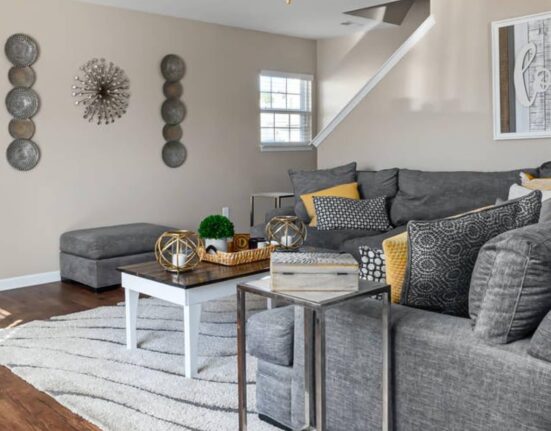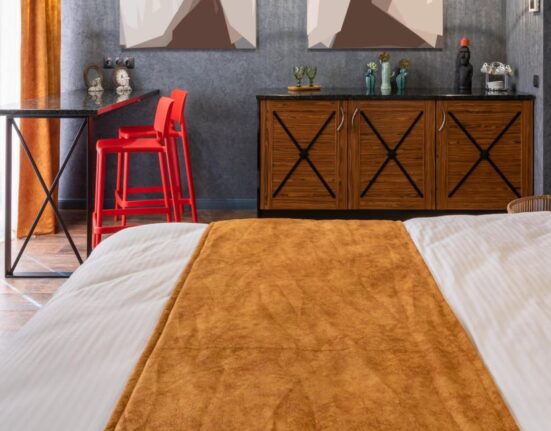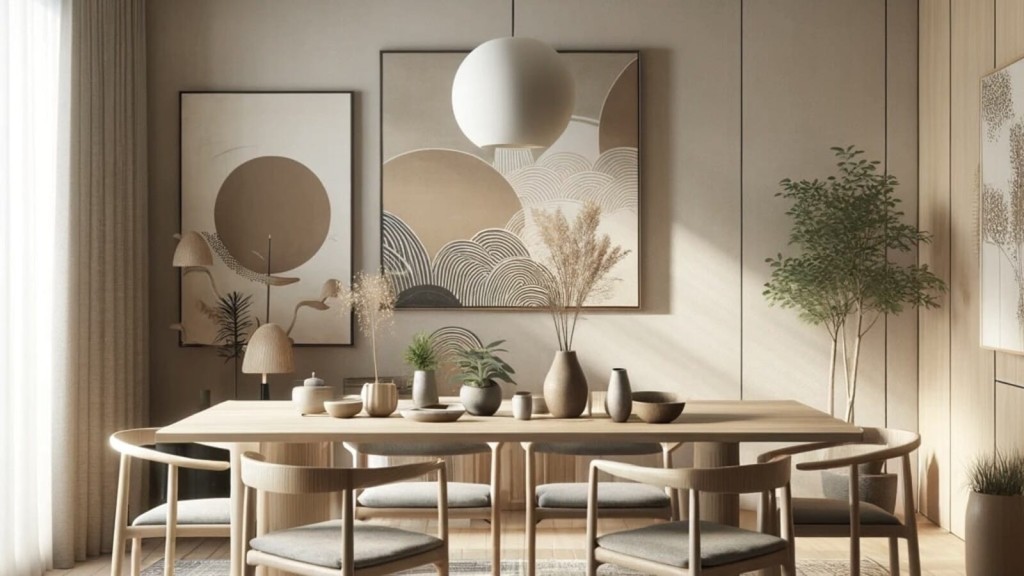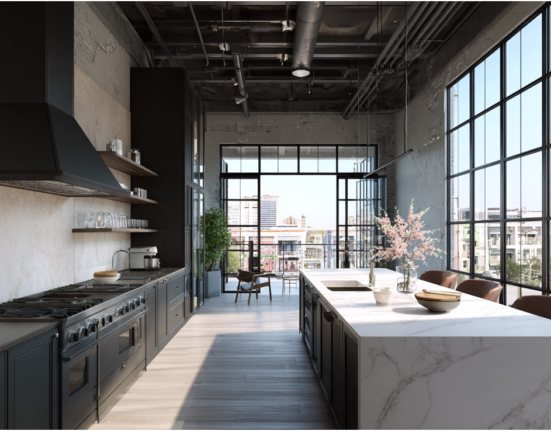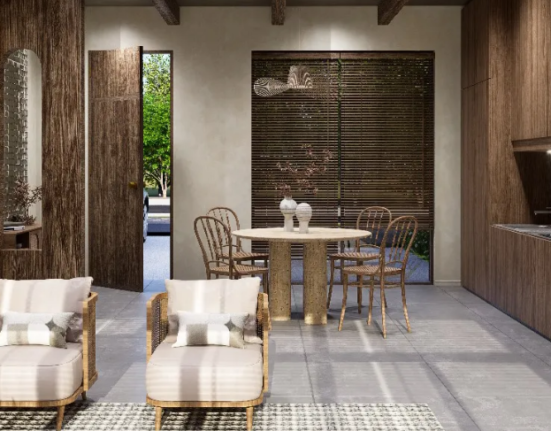Imagine walking into a space where simplicity reigns supreme, yet every piece feels intentional and thoughtful. The room is bathed in natural light, with clean lines and soft, neutral tones creating a tranquil atmosphere. There’s a feeling of balance—minimalism that doesn’t feel stark but relatively warm and inviting. This is Japandi, the interior design trend combining the best Japanese and Scandinavian aesthetics, delivering a serene and functional space perfect for modern living. As we explore the rise of Japandi interior design, we’ll uncover why this fusion has taken the interior world by storm and how its understated elegance might be precisely what you need to transform your home.
What Is Japandi Design?
Japandi is the result of blending two iconic design philosophies: Japanese minimalism and Scandinavian functionality. Both styles prioritize simplicity and practicality, yet their unique characteristics complement each other beautifully. Japanese design is rooted in wabi-sabi, the art of finding beauty in imperfection and embracing natural materials. On the other hand, Scandinavian design emphasizes hygiene—creating cozy, comfortable spaces that are clean and functional. The result? Japandi offers a minimalist aesthetic, blending organic elements with functionality without feeling cold or unwelcoming.
The Rise of Japandi Design
The Japandi trend has grown significantly in recent years, gaining popularity for its sustainable and clutter-free approach to home design. In a world that increasingly prioritizes mindfulness and wellness, it’s no surprise that people are drawn to Japandi’s calm and balanced style. According to a 2022 survey by Houzz, 31% of homeowners renovating their spaces leaned toward minimalistic designs, with Japandi being one of the top emerging trends. The same report showed that the demand for eco-friendly materials, such as bamboo and reclaimed wood—core elements in Japandi design—rose by 18%.
Critical Elements of Japandi Design
There are a few fundamental principles and elements to remember when bringing Japandi into your home.
- Minimalism Meets Functionality
Japandi focuses on keeping spaces simple and free from unnecessary clutter. Japanese and Scandinavian designs value functionality, meaning every item in the room should serve a purpose. This could be seen in furniture that doubles as storage or multipurpose items that maximize a space’s utility. In Japan, less is more, but less should also be practical.
In a 2023 study by Elle Decor, 65% of people seeking Japandi-inspired homes prioritized functionality, favoring pieces that blend aesthetic appeal with usefulness. This emphasis on form and function makes Japandi particularly attractive to those living in smaller urban spaces.
- Natural Materials
Japanese and Scandinavian designs celebrate using natural materials, which are central to the Japandi look. Bamboo, wood, linen, and wool are frequently used to create a space’s organic, grounded feel. These materials look beautiful and eco-friendly, contributing to the growing trend toward sustainable living.
Research by the International Interior Design Association in 2021 indicated that 42% of designers recommended natural materials as part of the Japandi aesthetic due to their environmental benefits and ability to create warmth in minimalist spaces.
- Neutral and Muted Colors
A muted, neutral palette characterizes Japandi interiors. Think soft greys, beige, cream, and earth tones, with occasional black or deep green pops for contrast. This color scheme promotes tranquility and allows the natural materials to shine without overwhelming the senses.
A 2022 report by Color Trends Journal found that 75% of Japandi-inspired homes favored neutral palettes, with homeowners appreciating the calming effect of subdued colors.
- Low, Grounded Furniture
In Japanese culture, being close to the ground is a way to connect with nature. Japandi interiors often feature low-profile furniture that fosters this grounded, minimalist vibe. Scandinavian furniture’s clean lines and modern forms complement the simplicity of Japanese design, creating sleek yet inviting spaces.
According to Statista, the global demand for Scandinavian furniture increased by 15% in 2023, a significant portion of that growth attributed to Japanese-style homes.
- Sustainability and Craftsmanship
Both design philosophies emphasize the importance of craftsmanship and sustainable practices. Handcrafted furniture made from natural and renewable materials is a staple of Japandi design. From handmade ceramics to wooden tables, the focus is on high-quality items built to last.
A 2021 Better Homes and Gardens survey showed that 60% of Japandi enthusiasts look for sustainability in their design choices, underscoring the movement’s alignment with eco-conscious living.
How to Achieve Japandi Style in Your Home
- Start with a Declutter
The foundation of Japandi design is minimalism, which means clearing away anything that doesn’t serve a functional or aesthetic purpose. Start by assessing each room and removing items that don’t contribute to the overall harmony of the space. This creates a clean slate for incorporating key Japandi elements.
- Choose Simple, Natural Furniture
When selecting furniture, prioritize pieces made from natural wood, bamboo, or linen. Low-profile furniture is ideal, offering a more grounded feel. Look for clean lines and simple forms that emphasize function over excess. A wooden coffee table with smooth edges or a linen-upholstered sofa can instantly bring a Japandi touch to your living room.
- Opt for Neutral Colors with Minimal Contrast
In Japandi interiors, bold colors are replaced with soft, neutral tones. Opt for beige, taupe, white, and muted greys for your walls, furniture, and textiles. Add subtle contrasts with black or dark green accent pieces—perhaps a chair, vase, or framed artwork—to add depth without disrupting the calming palette.
- Incorporate Nature
Plants are essential in Japandi interiors, bringing life and natural beauty into the home. Consider simple, easy-to-care-for plants such as succulents, ferns, or bonsai trees. Potted plants can be strategically placed on shelves or by windows, subtly enhancing the organic feel of the space.
According to the Journal of Biophilic Design, incorporating greenery into interior spaces has improved mental health and well-being by 20%, making it a key element in Japan’s calming design approach.
- Prioritize Quality Over Quantity
One of the most critical aspects of Japandi design is the principle of quality over quantity. This applies to everything from furniture to decor. Invest in timeless, durable pieces you’ll love for years rather than accumulating numerous items that quickly fall out of style or wear down.
Japandi’s Popularity in Modern Homes
Japandi design is gaining traction worldwide, particularly in urban environments where space is often limited and people seek more mindful, sustainable lifestyles. Its combination of clean lines, natural materials, and a peaceful atmosphere makes it ideal for those looking to retreat from daily life’s stresses.
In 2023, a report by Global Design Trends revealed that interest in Japandi design had increased by 27% year-over-year, particularly among millennial homeowners looking for practical, aesthetically pleasing living solutions.
Conclusion
Japandi’s interior design offers a harmonious blend of simplicity, functionality, and nature. By combining the minimalist elegance of Japanese design with the cozy functionality of Scandinavian style, Japandi creates spaces that are not only beautiful but also profoundly restful and sustainable. As more people embrace this style, Japandi continues to prove that less indeed can be more—especially when creating a home that feels like a sanctuary.
With its growing popularity and timeless appeal, Japandi might be the design trend that inspires your next home transformation. Whether you’re designing a single room or an entire home, incorporating the principles of Japandi will help you create a visually stunning and perfectly functional space.




